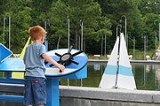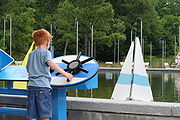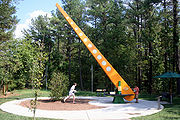
North Carolina Museum of Life and Science
Encyclopedia
The Museum of Life and Science (formerly known as the North Carolina Museum of Life and Science and originally titled the NC Children's Museum) is a science museum located in Durham, North Carolina
, USA, featuring an array of largely hands-on exhibits intended to illustrate concepts of natural science
.
The museum exists on some 80 acres (323,748.8 m²) bisected by Murray Avenue. The main building is located on the north tract, along with the Butterfly House, Farmyard, Grayson's Cafe, Train, Explore the Wild nature park, Catch the Wind, and Dinosaur Trail. The museum features both indoor and outdoor learning environments. The southern tract is now largely devoted to parking and administrative buildings, although prior to the construction of the new main building in the early 1990s, these structures contained the bulk of the museum's exhibit space.
The Museum has come under criticism from visitors for not mentioning evolution in its exhibits, despite having the word "Life" in its title and several significant exhibits that would merit such mention.
space program. Most of the artifacts on display are on long-term loan from the National Air and Space Museum
. Many of these are significant Project Apollo
-related artifacts, such as a moon rock, Neil Armstrong
's dosimeter, an Apollo Command Module test vehicle, a portion of a lunar rover
, and a full-sized mock-up of a Lunar Module. The MLS came into possession of these artifacts through the influence of James E. Webb
, the second NASA administrator and a native of North Carolina.
and tropical conservatory featuring a community of several hundred tropical butterflies representing dozens of species, as well as an array of tropical plants. The Bayer CropScience Insectarium, located in the Magic Wings Butterfly House, features exotic insects from around the world.
s, red wolves
, and lemur
s.
It features a 900 feet (274.3 m) boardwalk over a preserved 6 acres (24,281.2 m²) natural space, plus many multimedia exhibits. The exhibit opened in May 2006.
 Catch the Wind opened in the Summer of 2007 and features seven exhibits showing how the wind influences our environment.
Catch the Wind opened in the Summer of 2007 and features seven exhibits showing how the wind influences our environment.  A 30 feet (9 m) interactive tower elevates oversized representations of seed pods of trees native to North Carolina and drops them demonstrating how wind affects their travel. The ornithopter
A 30 feet (9 m) interactive tower elevates oversized representations of seed pods of trees native to North Carolina and drops them demonstrating how wind affects their travel. The ornithopter
ride features 12 lifting wings and lifts visits for a view of the area. The centerpiece of the area is a 5000 square feet (464.5 m²) elliptical sailboat pond where visitors can sail remote controlled sailboats.
Kiosks throughout the area allow visitors to listen to audio tracks of narratives, poems, and stories about the wind.
, still visible today from Murray Avenue. According to a 1965 pamphlet, the trail's original lineup featured a Seymouria
, an Eryops
, a Dimetrodon
, an Araeoscelis
, a Saltoposuchus
, a Yaleosaurus
, a Plateosaurus
, and a Camptosaurus
. Later additions included a T-Rex
and a Triceratops
. The trail also provided models of a mammoth
and a rhinoceros
for scale. The creatures were built by museum staff over a four-year period, culminating with the exhibit's completion in 1967. It was renamed the Dinosaur Trail in 1986. While most of the models still exist, the trail was rendered largely impassable by Hurricane Fran
in 1996 and has since fallen into disrepair. Between 2006 and 2009, local residents worked with the museum to remove some of the debris from the trail.
The brontosaurus model was vandalized during the early morning hours of June 1, 2009, when vandals removed a large portion of the neck and the entire head. At a later date, the head was found, and the Brontosaurus was repaired and improved through a partnership with the local Northgate Park neighborhood.
The final phase in the BioQuest expansion project, a new dinosaur trail (located in a different area on the museum's grounds) opened in July 2009. It features life size models of Albertosaurus
, Styracosaurus
, Troodon
, Maiasaura
, Stygimoloch
, Alamosaurus
, Leptoceratops
, and Edmontonia
. An interactive fossil dig area is also available where shovels and screens are available for children to search for, and take home, sharks teeth, coral, other fossils brought up from an abandoned mine in Eastern North Carolina which was once part of the ocean floor.
North Carolina
North Carolina is a state located in the southeastern United States. The state borders South Carolina and Georgia to the south, Tennessee to the west and Virginia to the north. North Carolina contains 100 counties. Its capital is Raleigh, and its largest city is Charlotte...
, USA, featuring an array of largely hands-on exhibits intended to illustrate concepts of natural science
Natural science
The natural sciences are branches of science that seek to elucidate the rules that govern the natural world by using empirical and scientific methods...
.
The museum exists on some 80 acres (323,748.8 m²) bisected by Murray Avenue. The main building is located on the north tract, along with the Butterfly House, Farmyard, Grayson's Cafe, Train, Explore the Wild nature park, Catch the Wind, and Dinosaur Trail. The museum features both indoor and outdoor learning environments. The southern tract is now largely devoted to parking and administrative buildings, although prior to the construction of the new main building in the early 1990s, these structures contained the bulk of the museum's exhibit space.
The Museum has come under criticism from visitors for not mentioning evolution in its exhibits, despite having the word "Life" in its title and several significant exhibits that would merit such mention.
Aerospace
The MLS has historically been most notable for its Aerospace exhibit, which focuses on the early NASANASA
The National Aeronautics and Space Administration is the agency of the United States government that is responsible for the nation's civilian space program and for aeronautics and aerospace research...
space program. Most of the artifacts on display are on long-term loan from the National Air and Space Museum
National Air and Space Museum
The National Air and Space Museum of the Smithsonian Institution holds the largest collection of historic aircraft and spacecraft in the world. It was established in 1976. Located in Washington, D.C., United States, it is a center for research into the history and science of aviation and...
. Many of these are significant Project Apollo
Project Apollo
The Apollo program was the spaceflight effort carried out by the United States' National Aeronautics and Space Administration , that landed the first humans on Earth's Moon. Conceived during the Presidency of Dwight D. Eisenhower, Apollo began in earnest after President John F...
-related artifacts, such as a moon rock, Neil Armstrong
Neil Armstrong
Neil Alden Armstrong is an American former astronaut, test pilot, aerospace engineer, university professor, United States Naval Aviator, and the first person to set foot upon the Moon....
's dosimeter, an Apollo Command Module test vehicle, a portion of a lunar rover
Lunar rover
The Lunar Roving Vehicle or lunar rover was a battery-powered four-wheeled rover used on the Moon in the last three missions of the American Apollo program during 1971 and 1972...
, and a full-sized mock-up of a Lunar Module. The MLS came into possession of these artifacts through the influence of James E. Webb
James E. Webb
James Edwin Webb was an American government official who served as the second administrator of NASA from February 14, 1961 to October 7, 1968....
, the second NASA administrator and a native of North Carolina.
BioQuest
In the mid-1990s, the museum announced a 4 phase expansion to their outdoor exhibits they called BioQuest.Magic Wings Butterfly House
A major attraction at MLS is the three-story glass Magic Wings Butterfly House, which opened in 1999, a butterfly zooButterfly zoo
A butterfly zoo, or butterfly house, is a zoo which is specifically intended for the breeding and display of butterflies. Some butterfly houses also feature other insects, spiders, scorpions, etc.- History :...
and tropical conservatory featuring a community of several hundred tropical butterflies representing dozens of species, as well as an array of tropical plants. The Bayer CropScience Insectarium, located in the Magic Wings Butterfly House, features exotic insects from around the world.
Explore the Wild
Explore the Wild is home to American black bearAmerican black bear
The American black bear is a medium-sized bear native to North America. It is the continent's smallest and most common bear species. Black bears are omnivores, with their diets varying greatly depending on season and location. They typically live in largely forested areas, but do leave forests in...
s, red wolves
Red Wolf
The red wolf is a North American canid which once roamed throughout the Southeastern United States and is a glacial period survivor of the Late Pleistocene epoch...
, and lemur
Lemur
Lemurs are a clade of strepsirrhine primates endemic to the island of Madagascar. They are named after the lemures of Roman mythology due to the ghostly vocalizations, reflective eyes, and the nocturnal habits of some species...
s.
It features a 900 feet (274.3 m) boardwalk over a preserved 6 acres (24,281.2 m²) natural space, plus many multimedia exhibits. The exhibit opened in May 2006.
Catch the Wind


Ornithopter
An ornithopter is an aircraft that flies by flapping its wings. Designers seek to imitate the flapping-wing flight of birds, bats, and insects. Though machines may differ in form, they are usually built on the same scale as these flying creatures. Manned ornithopters have also been built, and some...
ride features 12 lifting wings and lifts visits for a view of the area. The centerpiece of the area is a 5000 square feet (464.5 m²) elliptical sailboat pond where visitors can sail remote controlled sailboats.
Kiosks throughout the area allow visitors to listen to audio tracks of narratives, poems, and stories about the wind.
Dinosaur Trail
Long a local favorite, the Prehistoric Trail featured a number of life-size plaster amphibians, reptiles and dinosaurs set along a woodland path. Perhaps most notable was the BrontosaurusApatosaurus
Apatosaurus , also known by the popular but scientifically deprecated synonym Brontosaurus, is a genus of sauropod dinosaur that lived from about 154 to 150 million years ago, during the Jurassic Period . It was one of the largest land animals that ever existed, with an average length of and a...
, still visible today from Murray Avenue. According to a 1965 pamphlet, the trail's original lineup featured a Seymouria
Seymouria
Seymouria was a reptile-like labyrinthodont from the early Permian of North America and Europe . It was small, only 2 ft long...
, an Eryops
Eryops
Eryops meaning "drawn-out face" because most of its skull was in front of its eyes is a genus of extinct, semi-aquatic amphibian found primarily in the Lower Permian-aged Admiral Formation of Archer County, Texas, but fossils are also found in New Mexico and parts of the eastern United...
, a Dimetrodon
Dimetrodon
Dimetrodon was a predatory synapsid genus that flourished during the Permian period, living between 280–265 million years ago ....
, an Araeoscelis
Araeoscelis
Araeoscelis is an extinct genus of reptile, and one of the earliest diapsids. Fossils have been found in the United States, dating from the early Permian period.Araeoscelis was around long, and superficially resembled a modern lizard...
, a Saltoposuchus
Saltoposuchus
Saltoposuchus is an extinct genus of small , long- tailed crocodylomorph reptile , from the Norian of Europe. The name translated means "leaping crocodile". It has been proposed that Terrestrisuchus gracilis and Saltoposuchus connectens represent different ontogenetic stages of the same genus...
, a Yaleosaurus
Anchisaurus
Anchisaurus is a genus of basal sauropodomorph, and was an early herbivorous dinosaur. Until recently it was classed as a member of Prosauropoda. The name comes from the Greek αγχι/agkhi...
, a Plateosaurus
Plateosaurus
Plateosaurus is a genus of plateosaurid dinosaur that lived during the Late Triassic period, around 216 to 199 million years ago, in what is now Central and Northern Europe. Plateosaurus is a basal sauropodomorph dinosaur, a so-called "prosauropod"...
, and a Camptosaurus
Camptosaurus
Camptosaurus is a genus of plant-eating, beaked ornithischian dinosaurs of the Late Jurassic period of western North America. The name means 'flexible lizard', ....
. Later additions included a T-Rex
Tyrannosaurus
Tyrannosaurus meaning "tyrant," and sauros meaning "lizard") is a genus of coelurosaurian theropod dinosaur. The species Tyrannosaurus rex , commonly abbreviated to T. rex, is a fixture in popular culture. It lived throughout what is now western North America, with a much wider range than other...
and a Triceratops
Triceratops
Triceratops is a genus of herbivorous ceratopsid dinosaur which lived during the late Maastrichtian stage of the Late Cretaceous Period, around 68 to 65 million years ago in what is now North America. It was one of the last dinosaur genera to appear before the great Cretaceous–Paleogene...
. The trail also provided models of a mammoth
Mammoth
A mammoth is any species of the extinct genus Mammuthus. These proboscideans are members of Elephantidae, the family of elephants and mammoths, and close relatives of modern elephants. They were often equipped with long curved tusks and, in northern species, a covering of long hair...
and a rhinoceros
Rhinoceros
Rhinoceros , also known as rhino, is a group of five extant species of odd-toed ungulates in the family Rhinocerotidae. Two of these species are native to Africa and three to southern Asia....
for scale. The creatures were built by museum staff over a four-year period, culminating with the exhibit's completion in 1967. It was renamed the Dinosaur Trail in 1986. While most of the models still exist, the trail was rendered largely impassable by Hurricane Fran
Hurricane Fran
Hurricane Fran was a powerful Cape Verde-type hurricane of the 1996 Atlantic hurricane season that made landfall near Cape Fear in North Carolina at Category 3 strength. Throughout the eastern United States, early statistics on Fran reported 27 deaths and $3.2 billion in damage...
in 1996 and has since fallen into disrepair. Between 2006 and 2009, local residents worked with the museum to remove some of the debris from the trail.
The brontosaurus model was vandalized during the early morning hours of June 1, 2009, when vandals removed a large portion of the neck and the entire head. At a later date, the head was found, and the Brontosaurus was repaired and improved through a partnership with the local Northgate Park neighborhood.
The final phase in the BioQuest expansion project, a new dinosaur trail (located in a different area on the museum's grounds) opened in July 2009. It features life size models of Albertosaurus
Albertosaurus
Albertosaurus is a genus of tyrannosaurid theropod dinosaur that lived in western North America during the Late Cretaceous Period, more than 70 million years ago. The type species, A. sarcophagus, was apparently restricted in range to the modern-day Canadian province of Alberta, after which...
, Styracosaurus
Styracosaurus
Styracosaurus was a genus of herbivorous ceratopsian dinosaur from the Cretaceous Period , about 76.5 to 75.0 million years ago...
, Troodon
Troodon
Troodon is a genus of relatively small, bird-like dinosaur from the Late Cretaceous period . Discovered in 1855, it was among the first dinosaurs found in North America...
, Maiasaura
Maiasaura
Maiasaura is a large duck-billed dinosaur genus that lived in the area currently covered by the state of Montana in the Upper Cretaceous Period , about 74 million years ago....
, Stygimoloch
Stygimoloch
Stygimoloch is a putative genus of pachycephalosaurid dinosaur from the end of the Cretaceous period, roughly 65 million years ago...
, Alamosaurus
Alamosaurus
Alamosaurus is a genus of titanosaurian sauropod dinosaur from the Late Cretaceous Period of what is now North America. It was a large quadrupedal herbivore. Isolated vertebrae and limb bones indicate that it reached sizes comparable to Argentinosaurus and Puertasaurus, which would make it the...
, Leptoceratops
Leptoceratops
Leptoceratops , was a primitive ceratopsian dinosaur genus from the Late Cretaceous Period of what is now Western North America, at the same time as its giant...
, and Edmontonia
Edmontonia
Edmontonia was an armoured dinosaur, a part of the nodosaur family from the Late Cretaceous Period. It is named after the Edmonton Formation , the unit of rock it was found in.-Description:...
. An interactive fossil dig area is also available where shovels and screens are available for children to search for, and take home, sharks teeth, coral, other fossils brought up from an abandoned mine in Eastern North Carolina which was once part of the ocean floor.

